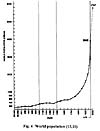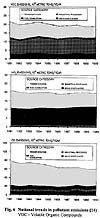1 DEMAND
The fact that life on earth is at the point of inflection, its growth rate increment turning over from positive to negative, is manifested by the menacing signs of the decaying quality of the environment (1-12). Today the protection against this impending disaster is a hot political issue. Just to get an impression of the relevant activities undertaken on the international scale over the last few years, consider the following events. The World Meteorological Organization (WMO) established the World Climate Research Program that, in turn, inaugurated the International Geosphere-Biosphere Program, adopted in 1986 by the International Council of Scientific Unions. In 1988 WMO sponsored, in conjunction with the United Nations Environmental Programme, the Intergovernmental Panel on Climate Change which in 1980 convened the Second World Climate Conference. Associated with these activities are the Montreal (1987) and London (1990) Protocols on protection of the ozone layer. All that culminated this year in the United Nations World Conference on Environment and Development, the so-called Earth Summit in Rio de Janeiro.
The universally accepted measures of atmospheric quality are the concentrations of ozone and carbon dioxide with the concomitant rise in surface temperature. The evolution of these parameters is presented, respectively, in Figs. 1, 2 and 3. Causally, the latter is the outcome of the greenhouse effect: the reduction of radiation from earth to space due to the long-wave filtering interference of the atmosphere. The particular culprits in this respect are the so-called greenhouse gases, i.e., quoting from the OECD report (1), "carbon dioxide (CO2), methane (CH4), chlorofluorocarbons (CFCs), nitrous oxide (N2O) and tropospheric ozone (03)".
Ultimately, their escalation is the consequence of the population explosion, Fig. 4 (13), and the concomitant human activities. Among them, of particular concern here are those associated with the rapidly growing use of internal combustion engines for transportation, as illustrated by Fig. 5 whose future trend is easily predictable in view of its amazingly linear character, Depicted in Fig. 6 is the contribution of the transportation sector in comparison to other sources of major pollutants (14). The concomitant effects on public health were, of course, a subject of extensive studies, as exemplified prominently by the compilation of comprehensive articles on various aspects of the subject edited by Watson, et al. (15).
2 RESPONSE
Interestingly enough, mankind's concern over the environmental menace has been first manifested, following the cataclysm of the Second World War, by the space program - an activity tantamount to admitting that life on earth may soon become unbearable so that exploring the universe for new homelands is a worthy pursuit. To begin with, thanks to the governmental support in the Soviet Union and United States, the program has been spectacularly successful.
Then, in response to the premise that, perhaps something could be done to deter the menace by protecting the quality of the atmosphere, a legislature was introduced in the U.S.A. by the Muskie Committee in terms of the 1970 amendments to the Clean Air Act, restricting significantly pollutant emissions from combustion systems with
3 COMMENTS
The space program was earmarked by clearly defined goals, such as the famous command of J. F. Kennedy to reach the moon, and it was enforced by a coordinated effort involving effective cooperation between government agencies with their research laboratories and the aerospace industry enhanced by close association with distinguished scientists.
Nothing of the sort has been done, as yet, for the protection of the environment - a cause evidently devoid of the appeal that the adventures of space exploration and warfare have to offer. Instead, the full brunt of responsibility for the development of preventive measures was left entirely to the industry in the belief that it is affluent enough to provide a satisfactory solution on its own, while the government provided not much more than legislative constraints and law enforcing agencies.
As a result, overwhelming reliance was put upon peripheral devices, such as the use of catalytic converters - chemical processing plants in the exhaust system - on one side, and, on the other, the improvement in fuel quality - an aim achievable by the introduction of alternative (in particular, natural gas, liquid petroleum gas, and methanol) and reformulated (16) fuels. Comparatively little has been accomplished, however, in catering to the essential origin of pollutants: the exothermic process of combustion taking place in the engine cylinder.
Less I be misunderstood, let me stress that this does not mean at all that there were no attempts made with this aim in mind. On the contrary, it is the notable failure of such well known concepts, conceived in this connection, as the stratified charge and lean burn, that is at the root of the major resistance of the industry to progressive techniques, especially those born out of the rapidly advancing frontiers of science: the fluid mechanics of turbulent flow (17) and the chemical dynamics of elementary steps in exothermic reactions (18). Paradoxically enough, the primary reason for this failure was the lack of awareness of the advances made concurrently in these fields of scientific endeavor. To top it off, there have been a number of studies carried out on the future of engine technology [vid. e.g. (19)], where the possibility of a significant progress achievable by ameliorating the combustion process in the cylinder has been conspicuously neglected. This omission became, in fact, characteristic of practically all the investigations concerning automotive pollution, as prominently manifested by the Auto/Oil Air Quality Improvement Research Program (20, 21) currently under way in the U.S.A.
The preventive legislature introduced in the U.S.A. has been imitated by all the industrial nations of the world, quite soon in Japan, and, with a considerable delay, in Europe. In spite of the time made thereby available, all the programs followed the same hasty pattern: urgently imposed legislative restrictions or incentives issued by the government, based primarily on what can be achieved by the use of catalytic converters, and unimaginative response of the industry, earmarked by notable omission of what can be accomplished in the engine cylinder.








